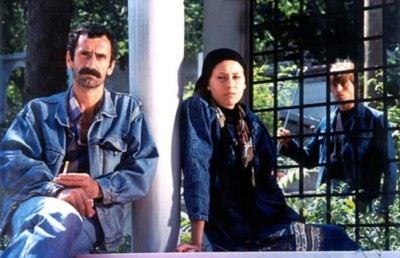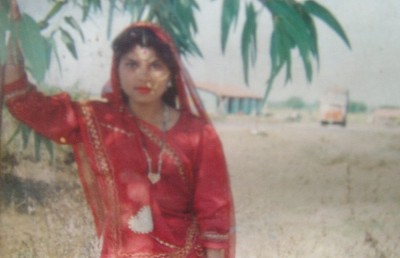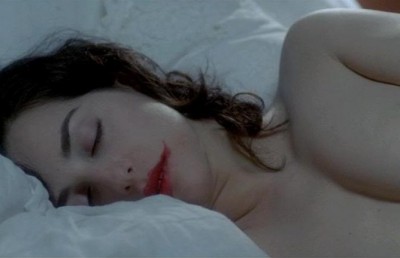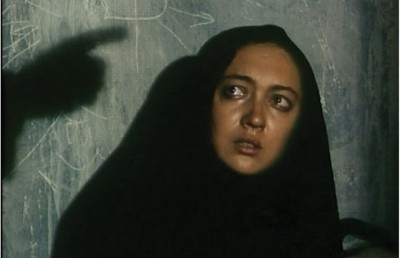Tales of Resilience: the Iranian Journey and The Ladies Room
The Episodic and the Wheel
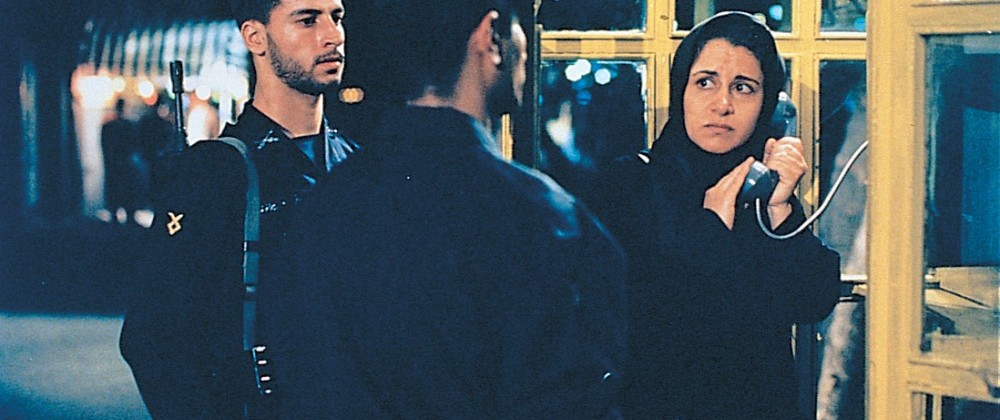
Have you seen Jafar Panahi’s The Circle, Abbas Kiarostami’s Ten and Marzieh Meshkini’s The Day I Became a Woman? Let me suggest that the “episodic” and the “wheel” are turning into formal elements of a post-paedocentric cinema in Iran (landmarked by films like Panahi’s White Balloon and Kiarostami’s Where is the Friend’s House) which is boldly engaging women to the extent of feminism. The Iranian Journey (Maysoon Panachi, 2003) is a documentary about a female long-distance bus driver—thus the wheels. The Ladies Room (Zananeh, dir. Mahnaz Afzali, 1999) fragments the daily conversations between women in a public lavatory—thus the episodic. And, they are both made by women and distributed by the Women Make Movies organization—thus the feminist!
The Iranian Journey is a documentary from a fairly objective point of view. It is the story of Ma’soomeh, the first and only long-distance female bus driver of the Middle East in the year 1999. Whether Ma’soomeh is the first female driver of the Muslim world is far less important than the fact that she is a bus driver in a presumably patriarchic society. By showcasing the strength of character and the will of a female individual, the Iranian Journey succeeds to debunk many a stereotypical notion of Iranian (or Muslim) patriarchy in the rest of the world. In addition, it glimpses into the cultural specificity of feminism, Iranian style!
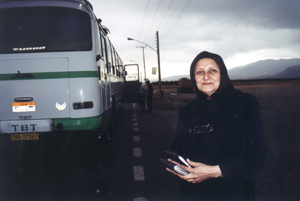
The Iranian Journey begins in the living room of the Mo’ammar family. We learn that having to become a bus driver was not Ma’soomeh’s choice, but a matter of survival. We then follow her through on one of her weekly cross-country trips from North to South of Iran. We also learn that her endeavors are not intended to prove a point about her ability and capability as a woman. She simply has to provide for her family. Her implicit desire to be accompanied by her husband (who is also a driver) and her expression of raised self-confidence in presence of her man will perhaps disqualify Ma’soomeh from any claim to feminism. However, the esteem that she instills in her daughters makes them aspire to becoming “the first women” to be a cinematographer, or a judge.
Of course, the inspiring female characters that stand against the –not only male, but– socio-political tyranny are quite populous on the screens of the Iranian (popular) cinema. (See author’s other article for details) The Iranian Journey, however, is not a (melo) dramatized version of the much-appreciated spectacle of female victimization by the big bad male tyrant. To the contrary, it points to the involvement of the men in facilitating the women’s participatory functions in the society. In that sense, it is an idealized depiction of the conditions of female empowerment within a certain cultural specificity. To this effect, the relationship between the Mo’ammar family members is not a stereotypical hierarchy in which the man makes the rules and the woman follows. Nevertheless, the need for understanding and cooperation are paramount; and the role of the husband (father) as the facilitator of social relationships for his wife (or daughters) is pivotal. From such perspective, the father figure becomes an important icon of support for the progress of the women, rendering the boundaries of achievement virtually endless. The Iranian (and state-approved/promoted) version of feminism, therefore, puts the emphasis not on the emancipation of the women, but on the sanctity of family and the cooperation and mutual respect for traditional gender roles. After all, although Ma’soomeh drives next to her sweetheart (husband of 30 years) from North to South of Iran, she still needs to make time for house chores bestowed upon any good matriarch.
However, the Iranian Journey is not a documentary about Ma’soomeh’s profession. Along every milestone of the bus journey, the director pauses to point to the facts and realities of the women involvement in the society. With an encyclopedic brevity and objectivity, we learn about legislations that segregate the society along the gender lines and the struggle of women like Ma’soomeh who thrive to break free of such restrictions. Similarly, the director stops in Qom, the heart of Shiite clericalism and the most religious city in Iran, to draw attention to the Fatemiyeh Medical Science University, an all-female teaching and research center in Qom. “The presence of the holy shrine of Hazrat Ma’soomeh (the sister of one of the 12 Shiite saints)” states Dr. Labbaf, the black-veiled soft-spoken principal of the university, “gives our girls a self esteem and confidence that in Islam women can attain high standards of scientific achievement to work along millions of men in their field.” What might perhaps shock the naïve consumer of the popular media’s lazy facts and figures about the fundamentalist Islam is that Dr Labbaf believes the only factor that can hold back women’s progress is not Islam but the cultural poverty in that society.
The Ladies Room, on the other hand, is not an objective documentary. The reality and the realism of the film take a second stage to the episodic self- narrations by odd characters that visit the ladies room in the Laleh Park. In that sense, more than being an informative documentary about the status of women in the Iranian society, it is a social critique of the status of the disenfranchised women of a marginal community, that of the prostitutes, the homeless, the abused and the mentally ill.
Located in the heart of Tehran, Laleh Park is the transversal passage of the Tehran university students, the middle class costumers of one of the most popular shopping districts of Tehran, the small merchants who are given small commerce booths to sell their crafts or produce, and their lower-income costumers. But Laleh Park is also infamous for housing the forbidden world of the pickpockets, drug addicts, prostitutes and runaway kids. The Ladies Room is the conversation of Mahnaz Afzali (an Iranian film actor) through particular research of Roya Karimi-Majd (one of the reporters of Iran’s feminist magazine, Zanan) with the female members of this community. Nonetheless, I would argue that an interview in the man’s room would have resulted in the same form of fieldwork social criticism. Truth is, the drug addicts and prostitutes are underprivileged in most parts of the world; but the film plays on the irony that in one of the strictest religious regimes of the world (Iran), these groups are relatively undisturbed by the state vigilantism, and to a great extent left alone with their own vice.
The film consists of eight episodes of conversation with a working prostitute, an epileptic drug addict, a suicidal runaway girl, a molested daughter, a homeless new mother, an old palm reader, a half-sane dentistry student and finally a retired prostitute. We learn about these characters from their episodic memories. Their stories are often melodramatic and appear to be told to attract attention. The validity of their stories is often critiqued by other members of the toilet club who point out to the contradictions of the narrative. Over all, the ladies room of the Laleh Park appears to be a vibrant female social club, with reasonable amount of gossip and judgment, and considerable amount of support and compassion.
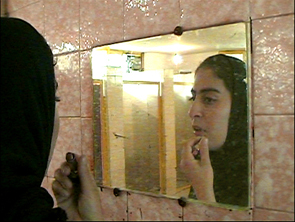
Yet, the anonymity of the characters, the obscured point of view, the absence of establishing shots that may anchor the film and its location, and at last the editing that surmounts the temporal and spatial ambiguity of the film, distance it from the spirit of a documentary. The abstraction of space, time and the characters, however, invites the viewer to seek a meaning beyond the drama of the narrated stories.
For example, the film opens on an older woman doing her prayers. The scene is brightly lit and she prays calmly while kneeling on the carpet. A teapot on the carpet next to her reminds the Iranian viewer of a typical grandmother and her inviting spirit and open door. We later learn that she is the host of the ladies room, but we never learn her name, her function, if she permanently lives in the public bathroom, and why. For those familiar with the Shiite rules and regulations about (bathroom related) cleanliness and filth in relation to the act of praying, the juxtaposition of prayer and toilet in the opening scene create an acute (if not shocking) sensitivity to seek the subtextual meaning of the film’s constructs.
It is not only the dichotomy of the spatial but also the dualities within each character that invite a reading of the sublime. For example, Madam Hakoopian is a Christian palm-reader who loves Imam Khomeini (the leader of the Islamic Revolution) and dislikes her Muslim daughter-in-law because she does not practice Islam well. From her appraisal of the Muslim holy Imam’s one might read her fear of belonging to a religious minority: in the face of a camera, she will not take any risk to jeopardize her peace and stability (and in the country of rhetoric, what better protection than praising the status quo?). But her devotion to Shiite’s iconic figures can also allude to the fact that the dominance of Islam in Iran is of a cultural and even a national nature and not a strictly religious one.
Another striking contradiction in the behavior of the characters is the mismatching between their stated and their enacted emotions. For example, Sepideh states that she is depressed and suicidal but she recounts the tale of her earlier failed suicides with humor and a significant level of self-assuredness that is uncharacteristic of a suicidal state. Or, Maryam who has become a drug addict to forget the pain of losing both her parents to the gallous, on charges of drug trafficking, admits that she is mentally unstable and lists a range of pathologies that make her impossible to live with. Yet she states that enough is enough and that she intends to reclaim her humanity, and that she is into the ninth day of unassisted and self-administered rehabilitation from drug addiction. Another one of these self-reliant characters is Leila, a seemingly simpleton who has a newborn in her arms and who sleeps in the park with her (new) husband and her other child from a different man. But Leila is proud and confident that she can help her husband in earning a life by making handcrafts to pay for a house and to feed their family.
In fact, all other characters of the film underline the perilous history of their lives with statements about their own strength, chastity, humor, will and choice. The Ladies Room thus transcends the assumed objective of being a film about victimized women and their social problems. In fact, episode after episode, just as we learn about the horrific events of each of the characters’ lives, we also learn about the tremendous degree of their resilience. Deeply scarred, in body and perhaps in spirit and mind, the women of The Ladies Room are testimonials of the will to survival. The most objective achievement of The Ladies Room, therefore, is to point to the possibilities for self-initiated support groups and communities that in the least provide a psychological shelter for the neglected members of the society.
Although different in style and in form, Iranian Journey and The Ladies Room overlap in one message: that the Iranian women seek the sources of their strength from within. The struggle of Ma’soomeh of the Iranian Journey is far different from that of Sima, Ra’na, Halimeh, Maryam, Leila and Mme Hakoopian of The Ladies Room. But these women parallel each other in a culture of determination and stubbornness that guides them through the hassles (in case of Ma’soomeh) and perils (in case of others) of the life. I want to suggest that this culture is not feminine or feminist, nor is it exclusively Iranian or Middle Eastern. Nevertheless, these films do debunk certain notions about what it means to be a woman in Iran. After all, women have made these movies and an Iranian woman is writing about them, the feminine in them cannot be ignored.
All photos taken from the Women Make Movies website.



